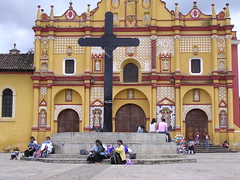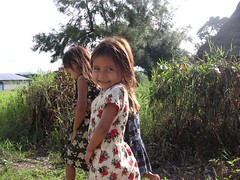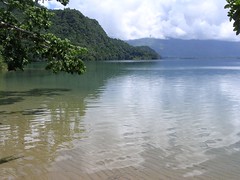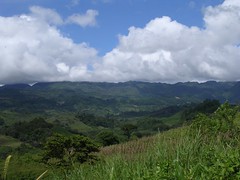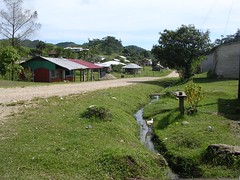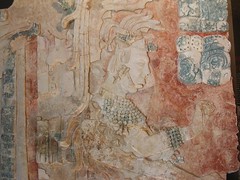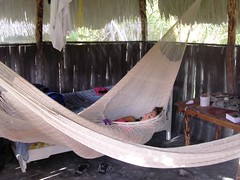The last Mexican night flies away slowly but inexorably, like the course of the rio Usumacinta, where we are staying now. The road that has lead us from the highlands near Comitàn to Frontera Corozal, it is a hard way through an incredible landscape. After the wonderful Lagunas de Montebello, some blue and green emerald lakes encircled by pines, the road falls down towards the jungle, along the border with Guatemala. That’s why it is called “carretera fronteriza”. Until the village of Benemerito de Las Americas, we observe the fruit of decades of totally irrational exploitation of the territory. With the promise of an easy land, the campesinos from the highlands were sent here (see the experience of ejido Emiliano Zapata), every time deeper in the heart of the Lacandon jungle. But the absence of a clever agricultural project forced to an extensive and unproductive exploitation of the land. As dramatic consequence, we see a forest in agony and the return of the large estate owners, in places where they could never have arrived even with enormous resources. Frontera Corozal isn’t free from these problems, but its inhabitants seem to have found a valid alternative in projects of “ecotourism”, thanks to the beauty of the river Usumacinta and the wealth of life along its sides (finally we have seen the howler monkeys!). Moreover a few kilometers from the community there are Mayan ruins such as Yaxchilan and Bonampak.
San Cristobal de las Casas
We spent some days in San Cristobal, the historical and touristic heart of Chiapas. The city is really pleasant and interesting, maybe to much visited. As usual we have been attracted in a special way by the market and “artesania” quarters, thanks to the eclectic contribution of the women from the pueblos situated on the highlands around the city (San Juan Chamula, Amatenango del Valle, Simojovel, Zinacantàn, Oventic, Chenalhò…). In the hostel where we were lodged, we met some funny people and we spent a good time. Every day, walking along the narrow and coloured streets of San Cristobal, we discovered many new locals, bars and “comedores”, but our thoughts are mainly projected towards Guatemala and the place where to cross the border.
From the jungle and Zapatist communities
Last part. Early in the morning the micro leaves from San Quintin to Las Margaritas. An even harder trail in comparison with the one from Ocosingo. After some hours of travel we reach the “caracol” La Realidad: as our driver knows anyone and stops for a pause, we talk with some people, trying to understand if we can stay in the community. Unfortunately we are not so lucky and the “autoridades” cannot receive us, therefore we decide to continue. In the following days, we know a woman who works in the communities (volunteering here is generally well accepted) and she confirms to us that with strangers, people react in unforeseeable ways: if you are not accepted, the refusal is inexorable. After nearly ten hours of travel we reach Las Margaritas, a small city where we stop for the night: once more we find ourselves in a world of concrete houses, paved roads and cars… something sadly familiar.
An unforgettable experience in the heart of the Latin American life is concluded, we are tired but excited. We think about the fortune of being allowed to know the indigenous communities of Lacandon jungle in this way. Maybe the works of road pavement will carry some light changes in the life of people who inhabit these places, but surely they will ruin the authentic atmosphere we have breathed… how much instable is the equilibrium between progress and maintenance of the popular traditions?
Manuèl, su familia y la tierra
Fourth part. At night, Manuèl and his wife told us the history of their life, that is the history of many campesinos, indigenous people and Latin Americans, before and after them. An adventure begun in ’67, when ejido Emiliano Zapata was still an idea on paper and the Lacandon jungle was many times greater than now. They told us about a year of sacrifices in order to save money for the flight and their first inspection in the territory of the future ejido: even if the forest scared them, Manuèl had no choice and in ’68 abandoned his pueblo and took possession of its portion of land, together with his wife. Then followed years of hard fight against the jungle, hunger and diseases: of the 65 founders of the community, only twenty resisted the first year. For some months they ate caracoles (shells), then succeeded to carry the first animals, corn and the fruit plants. After many years, Manuèl shows us proudly his nephews and the school they have been able to build. We have the feeling that the community works very well and the people help themselves to each other, but there are still well-known and usual problems. The school does not supply a continuous service (teachers come from Ocosingo and change too often), the doctor passes once a week and never succeed to visit everyone (the roads in the region are unpaved and hard). Drugs are used with parsimony, but often they are something unapproachable…
While we eat our “sopa de verduras”, we think to the last words of Manuèl: “Young people go away because they do not find any job here and we are getting old, someone has already died. But we will resist until the last day on our piece of land, conquered with sweat, blood and tears”. In order to greet us, Manuèl sings the hymn of the ejido, he and his wife start crying: we learn that in the difficult things you can find the most serene way of living…
Ejido Emiliano Zapata and Laguna Miramar
Third part. Adolfo awakes us very early in the morning, but we are slow and after a short breakfast and the research of the boots, when we are ready to leave, the sun is already high on the horizon… we begin to walk along a path of about ten kilometers, that will take us on the sides of the Laguna Miramar. Immediately we realize that the intense rainfall of the night have deeply marked the way, reducing it to a mud strip. We share a long part of the way with a man from the ejido and his two sons, exchanging some impressions, but above all listening their fascinating language, the tzotzil (together to the tzeltal, the main of the languages of Mayan origin still spoken in Chiapas). It becomes almost an epic adventure, between milpas (cornfields), skeletal horses and jungle, but at the end the hard work is repaid: the lagoon is a crystalline water mirror, encircled by a luxuriant vegetation and lacking in human traces. For some hours we forget the whole world, but finally we need to return to the ejido along the same path, and it carries us back to the reality.
Towards the Lacandon Jungle
Second part. It’s early in the morning, but the emotion keep us wide awake: we put all our dreams on the “camioneta” that will take us to San Quintin, ready to share them with the other people who undertake the travel towards the Lacandon jungle with us. Left Ocosingo, the road sweetly follows the valleys covered by pines and corn fields… we go down slowly, the air gets more humid and the forest becomes more and more green. The unpaved and muddy road pushes us through small villages, from the wooden huts appear the looks astonished but curious of the children. Exceeded the caracol zapatista of Francisco Gomez, the pines leave space to the jungle and begins to rain. Late in the evening we finally reach Saint Quintin, where the road finishes: the feeling is to find a confused and disordered community. Therefore, we decide to walk until ejido Emiliano Zapata, where the “Secretario de turismo”, Adolfo receives us. We are lodged in a splendid cabaña close to the river, surrounded by the jungle and the howls of its animals. After a short swim in the river, we eat with other three boys in the house of señor Manuèl, his wife prepares us a delicious “pollo en mole”, cooked on firewood. We are very tired and in the dark of the jungle we fall aslept without offering resistance.
Indigenous communities of Chiapas
First part. During the period spent in Ocosingo, we have been observers of a hard but intense life. Day after day, people became more and more friendly and the last evening we knew a family coming from a pueblo on the road to San Cristobal, all together with the father who sold candies in the public square. The mother, a very young woman, was so proud of her five sons and she had all the reasons as they were beautiful, curious and friendly. We passed all the evening playing with them… we think that the concept of poverty cannot be defined in absolute terms: happiness is to be astonished and smile for the simplest things and those three children transmitted us this feeling. Every community, every people should be able to satisfy its elementary needs (food, water, health and peace) following the road traced from its own history and culture. Freedom is not for anyone!
The story that follows comes from our experience in the Lacandon Forest (“Selva Lacandona”), to tightened contact with some indigenous communities of Chiapas: a few days that however allowed us to graze an authentic, unforgettable and sometimes extremely contradictory situation.
Ocosingo, Chiapas
Chiapas is the Mexican state where the echoes from the past are more evident and the indigenous population is more numerous. We receive a further confirmation of this fact in Ocosingo: it is a quite but lively market, where many people from the nearby villages and communities come to sell land products and craftsmanship. We perfectly know that in the valleys around us the world is divided in two parts, but we are intentionally visiting these places without preconceptions. In addition, sometimes it seems quite difficult to talk with people about these themes… in the market “Tianguis campesino”, women who sell goods surrounded by their sons, give us sweet and unforgettable smiles. We are in a new world, which causes us deep emotions.
Ruins of Palenque
We loved the archaeological site of Palenque: the beautifulness and greatness of its temples reveal the history of a rich Mayan city and of legendary figures (above all, Pakal), however leaving them in the mystery. The jungle covers the ruins, creating a wonderful set. Unavoidably it’s the forest itself which becomes the main actor, with its colours and sounds. Numberless insects and birds, toucans and howler monkeys begin their own concert, while the “Palacio de las inscripciones” tell us about a healthy past: our imagination runs between the jungle and the ruins… it’s impossible not to remain fascinated.
Travel towards Chiapas
After almost three weeks of Caribbean, sun and paradisiac beaches, we ended our staying in the Yucatan peninsula moving from Tulum to Mahahual. This small village of fishermen, in the heart of the wonderful Costa Maya, let us feel the genuine rhythms of Mexican Caribbean. We slept in a cabaña, on our legendary Mayan hammocks (made of magüey)… here we found a very particular ecosystem, just within 100 meters: tropical jungle, mangroves, coconut palms and coral reef.
Finally, we started again our travel towards Chiapas. After a short staying in Chetumal, Quintana Roo’s capital, we passed near the “Reserva de la Biosfera de Calakmul”, along the border between Mexico, Belize and Guatemala, crossing numberless villages of campesinos and the deep jungle. Suddenly the great Yucatan plain ended and we entered a green region of hills, announcing the Sierra Madre and the city of Palenque. Finally we arrived in Chiapas, another dream of our life…

